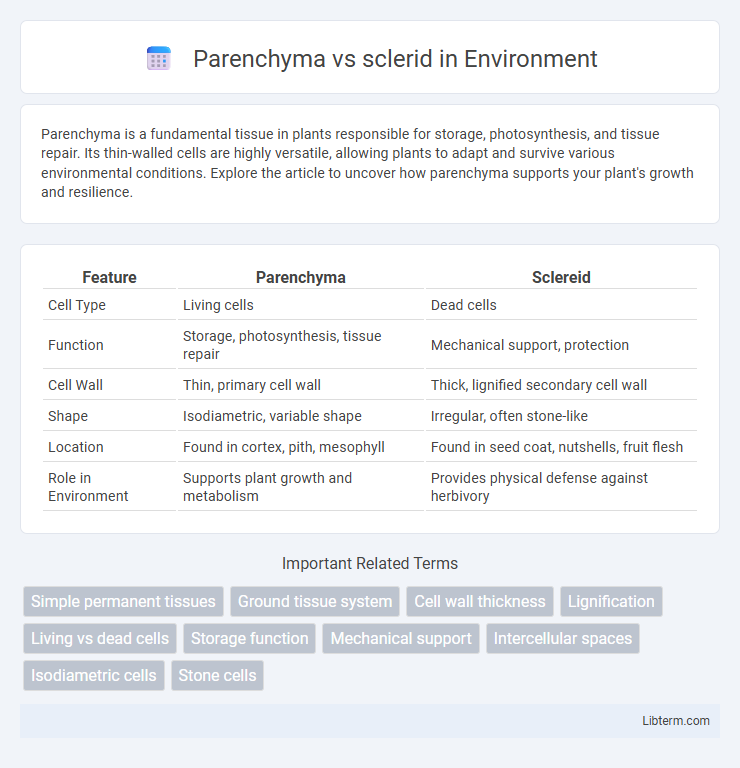Parenchyma is a fundamental tissue in plants responsible for storage, photosynthesis, and tissue repair. Its thin-walled cells are highly versatile, allowing plants to adapt and survive various environmental conditions. Explore the article to uncover how parenchyma supports your plant's growth and resilience.
Table of Comparison
| Feature | Parenchyma | Sclereid |
|---|---|---|
| Cell Type | Living cells | Dead cells |
| Function | Storage, photosynthesis, tissue repair | Mechanical support, protection |
| Cell Wall | Thin, primary cell wall | Thick, lignified secondary cell wall |
| Shape | Isodiametric, variable shape | Irregular, often stone-like |
| Location | Found in cortex, pith, mesophyll | Found in seed coat, nutshells, fruit flesh |
| Role in Environment | Supports plant growth and metabolism | Provides physical defense against herbivory |
Introduction to Plant Cells: Parenchyma and Sclereids
Parenchyma cells are fundamental plant cells characterized by thin primary cell walls, a large central vacuole, and living cytoplasm, playing key roles in storage, photosynthesis, and tissue repair. Sclereids are a type of sclerenchyma cell, distinguished by thick, lignified secondary walls, providing mechanical support and protection in fruits, seeds, and nutshells. While parenchyma cells contribute to metabolic functions, sclereids enhance plant structural integrity through their hardness and rigidity.
Overview of Plant Tissue Types
Parenchyma and sclereids are fundamental plant tissue types involved in different functional roles within the plant. Parenchyma cells are living, thin-walled, and primarily responsible for photosynthesis, storage, and tissue repair, forming the bulk of ground tissue in leaves, stems, and roots. Sclereids, a type of sclerenchyma cell, are thick-walled, dead at maturity, providing mechanical support and protection, commonly found in seed coats, nutshells, and nutshells.
Parenchyma Cells: Structure and Characteristics
Parenchyma cells are fundamental plant cells characterized by thin primary cell walls and a large central vacuole, facilitating storage, photosynthesis, and tissue repair. These cells exhibit a loosely packed, isodiametric shape, promoting efficient gas exchange and metabolic activities in leaves, stems, and roots. Parenchyma plays a crucial role in plant growth and regeneration due to its ability to divide and differentiate into various specialized cells.
Sclereid Cells: Structure and Unique Features
Sclereid cells, a type of sclerenchyma tissue, exhibit thick, lignified cell walls that provide structural support and protection in plants. Their irregular shape and dense, hardened texture distinguish them from parenchyma cells, which are typically thin-walled and flexible for metabolic functions. These specialized cells contribute to the gritty texture in fruits like pears and serve as protective barriers against herbivory and mechanical damage.
Main Functions of Parenchyma Cells
Parenchyma cells primarily function in photosynthesis, storage, and tissue repair within plants, facilitating the synthesis and storage of nutrients such as starch and oils. These living cells have thin cell walls, allowing efficient gas exchange and water retention, which supports metabolic processes. In contrast, sclerids provide mechanical support and protection through their thick, lignified walls, contributing to the plant's structural integrity.
Functional Roles of Sclereids in Plants
Sclereids provide structural support and protection, contributing to the hardness and rigidity of plant tissues such as seed coats and nutshells. They play a critical role in deterring herbivory due to their thick, lignified cell walls that make plant parts less palatable and more resistant to mechanical damage. Unlike parenchyma cells that mainly function in storage, photosynthesis, and tissue repair, sclereids specialize in reinforcing plant integrity and defense mechanisms.
Key Differences Between Parenchyma and Sclereids
Parenchyma cells are living, thin-walled, and primarily involved in storage, photosynthesis, and tissue repair, while sclereids are dead at maturity, with thick, lignified walls that provide mechanical support and protection. Parenchyma cells are generally large with a central vacuole and flexible structure, whereas sclereids vary in shape, often stone-like or branched, contributing to the hardness of seed coats, nutshells, and gritty textures in fruits. The key differences lie in their function, cell wall thickness, and presence or absence of living protoplasm, reflecting their distinct roles in plant tissue architecture.
Distribution and Location in Plant Organs
Parenchyma cells are widely distributed throughout the plant, found in the cortex, pith, mesophyll of leaves, and the soft parts of stems and roots, serving primarily in storage, photosynthesis, and tissue repair. Sclerids, a type of sclerenchyma, are localized in seed coats, nutshells, and the gritty textures of pear fruit, providing mechanical support and protection. The extensive presence of parenchyma contrasts with the more restricted, specialized occurrence of sclerids in plant organs.
Importance in Plant Growth and Defense
Parenchyma cells play a critical role in plant growth by facilitating photosynthesis, storage, and tissue repair due to their thin walls and metabolic activity. In contrast, sclereids, a type of sclerenchyma cell, provide mechanical support and defense by forming hard, lignified structures that protect against herbivory and physical damage. The complementary functions of parenchyma and sclereids ensure both metabolic vitality and structural integrity in plants, supporting overall growth and resilience.
Conclusion: Comparative Significance in Botany
Parenchyma cells play a crucial role in photosynthesis, storage, and tissue repair due to their thin walls and ability to remain alive, emphasizing their importance in plant growth and metabolic functions. Sclerids, characterized by their thick, lignified walls and dead state at maturity, provide mechanical support and protection, contributing to the structural integrity and defense mechanisms in plants. Understanding the comparative significance of parenchyma and sclerids highlights their complementary roles in plant development, combining metabolic versatility with structural resilience crucial for adaptive success in varied environments.
Parenchyma Infographic

 libterm.com
libterm.com